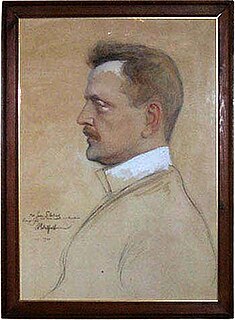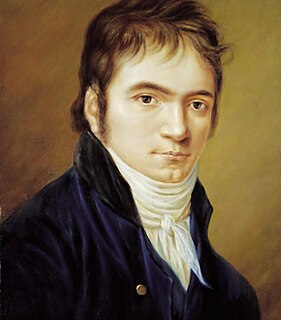Related Research Articles

In music, a cadenza is, generically, an improvised or written-out ornamental passage played or sung by a soloist or soloists, usually in a "free" rhythmic style, and often allowing virtuosic display. During this time the accompaniment will rest, or sustain a note or chord. Thus an improvised cadenza is indicated in written notation by a fermata in all parts. A cadenza will usually occur over the final or penultimate note in a piece, the lead-in or over the final or penultimate note in an important subsection of a piece. It can also be found before a final coda or ritornello.

The Violin Concerto in D minor, Op. 47, was written by Jean Sibelius in 1904, revised in 1905. It is his only concerto. It is symphonic in scope, with the solo violin and all sections of the orchestra being equal voices. An extended cadenza for the soloist takes on the role of the development section in the first movement.

Felix Mendelssohn's Violin Concerto in E minor, Op. 64, is his last large orchestral work. It holds an important place in the violin repertoire and is one of the most popular and most frequently performed violin concertos in history. A typical performance lasts just under half an hour.

Edward Elgar's Cello Concerto in E minor, Op. 85, his last notable work, is a cornerstone of the solo cello repertoire. Elgar composed it in the aftermath of the First World War, when his music had already gone out of fashion with the concert-going public. In contrast with Elgar's earlier Violin Concerto, which is lyrical and passionate, the Cello Concerto is for the most part contemplative and elegiac.

Ludwig van Beethoven's Piano Concerto No. 1 in C major, Op. 15, was written in 1795, then revised in 1800. It was possibly first performed by Beethoven at his first public concert in Vienna on 29 March 1795. It was first published in 1801 in Vienna with dedication to his pupil Princess Anna Louise Barbara Odescalchi, known to her friends as "Babette".
Violin Concerto No. 2 in D minor, Op. 22, by the Polish violin virtuoso, Henryk Wieniawski, may have been started in 1856, but the first performance did not take place until November 27, 1862, when he played it in St. Petersburg with Anton Rubinstein conducting. It was published in 1879, inscribed to his dear friend Pablo de Sarasate.

Barry Emmanuel Tuckwell, was an Australian French horn player who spent most of his professional life in the United Kingdom and the United States. He is generally considered to have been one of the world's leading horn players.

Ralph Vaughan Williams's Symphony No. 3, published as Pastoral Symphony and not numbered until later, was completed in 1922. Vaughan Williams's initial inspiration to write this symphony came during World War I after hearing a bugler practising and accidentally playing an interval of a seventh instead of an octave; this ultimately led to the trumpet cadenza in the second movement.

Claude Arrieu was a prolific French composer. Claude Arrieu was the pseudonym used by Louise-Marie Simon.
Donald Oscar Banks was an Australian composer of concert, jazz, and commercial music.
The Quintet in E♭ major for Piano and Winds, K. 452, was composed by Wolfgang Amadeus Mozart on March 30, 1784 and premiered two days later at the Imperial and Royal National Court Theater in Vienna. Shortly after the premiere, Mozart wrote to his father that "I myself consider it to be the best thing I have written in my life." It is scored for piano, oboe, clarinet, horn and bassoon.
Antonín Dvořák's Piano Quintet No. 2 in A major, Op. 81, B. 155, is a quintet for piano, 2 violins, viola, and cello. It was composed between August 18 and October 8, 1887, and was premiered in Prague on January 6, 1888. The quintet is acknowledged as one of the masterpieces in the form, along with those of Schumann, Brahms and Shostakovich.

Piano Trio No. 1 in D minor, Op. 32, for violin, cello and piano is a Romantic chamber composition by the Russian composer Anton Arensky. It was written in 1894 and is in four movements:
- Allegro moderato – Unlike the agitated opening melody of the first movement from Mendelssohn's Piano Trio No. 1, this piece opens gently, lyrically and elegiacally, setting an autumnal mood of the whole work. This movement ends with a coda marked "Adagio".
- Scherzo – The movement in the parallel key features flying notes, and a waltz-like middle section mainly in B-flat major. The movement is cheerful throughout.
- Elegia (Adagio) – Following the cheerful scherzo comes the contrasting and sad slow movement in the subdominant minor. Presenting no formal grief but memorial thoughts, this movement is deeply elegiac but not funereal. The middle section begins in G major but involves a number of key modulations, which makes the passage that initially evokes a brighter mood even more affecting yet dreamlike later on.
- Finale – Back in D minor, the movement opens dramatically. Later comes a recollection of themes from the third and first movements, which is followed by a turbulent ending that restates the primary theme of this movement.

The Piano Quartet No. 1 in G minor, Op. 25, was composed by Johannes Brahms between 1856 and 1861. It was premiered in 1861 in Hamburg, with Clara Schumann at the piano. It was also played in Vienna on 16 November 1862, with Brahms himself at the piano supported by members of the Hellmesberger Quartet. Like most piano quartets, it is scored for piano, violin, viola and cello.

Henri Tomasi was a French classical composer and conductor. He was noted for compositions such as In Praise of Folly, Nuclear Era and The Silence of the Sea.

The Sonatine (Sonatina) for violin and piano is a chamber music composition by Karlheinz Stockhausen, written while he was still a student in 1951. It carries the work-number ⅛ in his catalogue of works.
Written in 1846, the Piano Trio in G minor, opus 17 by Clara Schumann was her only piano trio and was composed during her stay in Dresden 1845-1846. During the development of the Trio, she was going through hardships in life. Her husband Robert Schumann was extremely ill. This trio was completed during the summer of 1846 when they traveled to Norderney in attempts to improve Robert's health conditions. While in Norderney, Clara suffered from miscarriage. A year after the composition of her piano trio, Robert composed his first piano trio, op.63. It is seen that Clara's trio has had great influences on Robert's trio as they both share many interesting similarities. Their works were frequently paired at concerts.
The Trio for horn, violin, and piano, Op. 44, is a chamber music work by the English composer Lennox Berkeley. It was composed in the early 1950s and was premiered in March 1954 in London. A performance takes about 15 minutes.
The Violin Sonata No. 2 in E♭ major, Op. 102, was written by Camille Saint-Saëns from February to March 1896, and premiered on 2 June 1896 in Paris.
The Piano Quartet in B♭ major, Op. 41, also known as the Piano Quartet No. 2, was written by Camille Saint-Saëns in February 1875. Dedicated to Jules Foucault, it was premiered on 6 March 1875 in Paris. It has been called one of Saint-Saëns' neglected masterpieces and is in the core repertoire of the piano quartet.
References
Cited sources
- Covell, Roger. 1967. Australia's Music: Themes for a New Society. Melbourne: Sun Books.
- Hill, Douglas. 2001. Collected Thoughts on Teaching and Learning, Creativity, and Horn Performance. Miami: Warner Bros. Publications. ISBN 978-0-75790-685-5 (cloth); ISBN 0-75790-159-X (pbk).
- Sitsky, Larry. 2011. Australian Chamber Music with Piano. Canberra: ANU E Press. ISBN 978-1921862403 (pbk); ISBN 9781921862410 (ebook).
- Żuk, Zbigniew. 1997. "Dedicated to the Brilliant Horn-Soloist Barry Tuckwell". Liner notes to Horn Trios. Zbigniew Żuk, horn; Jan Stanienda, violin; Piotr Folkert, piano. Recorded 18–20 March 1997 in Bydgoszcz Philharmonia Hall. CD recording, 1 disc: 12 cm, digital, stereo. Żuk Records CD 310Bremerhaven: Żuk Records.